Gold price forecast. Go long, hold or short? Using relative value as a trading signal
To understand Gold and its recent rise to US$1876 and subsequent decline one has to take a step back in time and look at the price series of the yellow metal over the last 6 years.
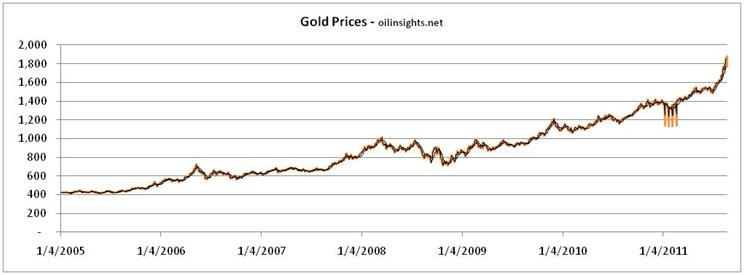
It is difficult to look at this chart in isolation and build a model. For context you have to add the lagged effect of two American wars (Afghanistan, Iraq) on the US dollar, a commodity spike in 2007-2008, the collapse in commodity prices, the global financial meltdown, the subsequent deep recession and the run on the Euro in 2010-2011.
Given this context the common explanation for the rise in the price of Gold is the relative value argument. Gold captures, retains and defends long term purchasing power of any commodity without the interference of central bank intervention and currency manipulation. Its price adjusts to reflect the loss of value in baseline currencies and goes up and down as markets re-price commodities in gold from one central bank inflationary intervention to the next.
For example between January 2005 and August 2008, the price of Oil and Gold in US dollar terms shared the same direction and trend – which corresponded loosely to the reduction in purchasing power of the US$ over this time period.
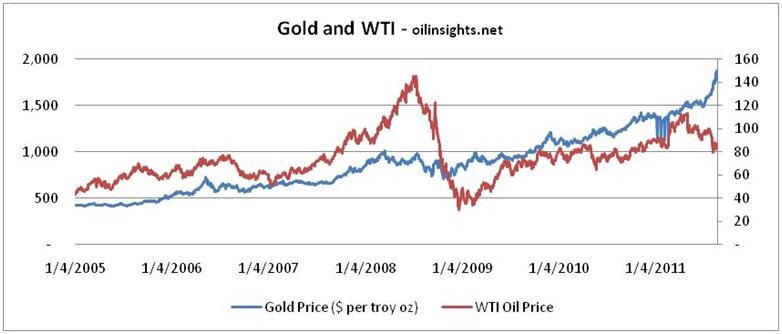
As the world moves away from hiding dollars as a store of value under their mattresses, two things happen. The US dollar depreciates as more buyers move away to explore alternate options when they perceive that the US dollar is no longer a guaranteed store of value (it can go down as well as up and is likely to buy less in the future compared to today). Second the dollar value of commodities goes up as markets compensate for the reduced value of the currency (today as well as in the future). Together the two drivers feed on each other to create a self fulfilling prophecy.
Coming back to the graph depicting the relationship between oil and gold we see that the relationship between oil and gold broke down in the last two quarters of 2008 before resuming again in early 2009 and breaking down again in the last three months of 2011.
An alternate and easier way of highlighting at the same relationship is the gold to crude oil ratio. How many barrels of oil a troy ounce of Gold buys now? How does this compare to historical relationship between the two commodities.

While the truncated graph above shows a distinct and stable trend between September 2009 and August 2011, we can see that the relationship underwent a dramatic change during the collapse of commodity prices in 2008 and hovered between 6 and 21 barrels of oil for an ounce of gold before settling down with an average ratio centered around 15 barrels of oil for an ounce of gold.
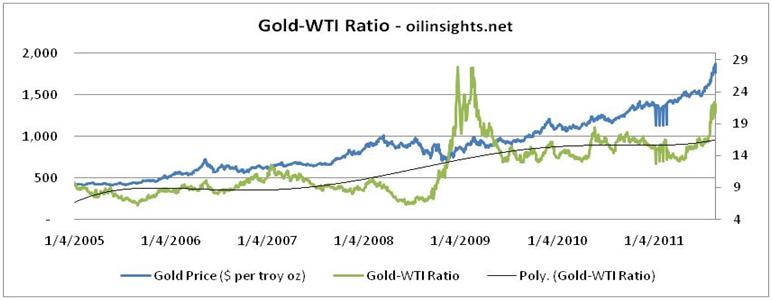
A more complete graph of the same data set shows that the relationship was stable around 9 barrels for 3 years before finding a higher mean reverting center in 2009. The polynomial curve fit (the thin black line) smoothes the transition from one curve to the next and highlights the mean reverting center for the two periods.
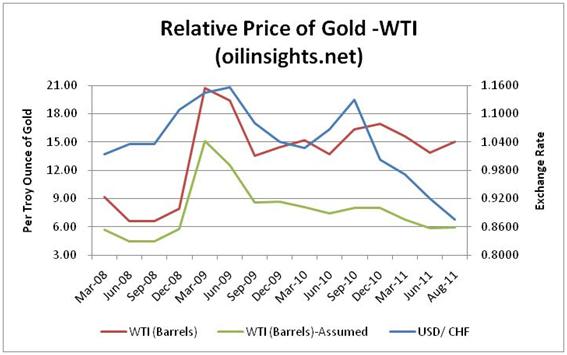
The final graph above completes the presentation of the relative value argument.
Let us assume that compared to US$, Euro and Yen, the Swiss Franc is a relatively stable store of value. Let us also assume that in volatile markets it represents the right pricing relationships with other commodities compared to the three currencies measured above. The green line (the assumed WTI ratio) shows what the ratio would have looked like if we held the price of gold constant at US$ 600 an ounce. The reddish maroon line shows the actual ratio. The blue line shows the depreciation in the value of the US dollar when compared to the Swiss Franc. Adjusting for lag you can see that at least part of the jump in the value of oil and gold when measured in US dollar terms can be explained by the associated deprecation of the US dollar.
The relative value argument doesn’t just hold for oil and gold. It holds for a large number of commodities. We run the same relative value analysis (how many units of the commodity in question does an ounce of gold buy?) for Natural Gas, Aluminum, Platinum, Steel, Corn, Cotton, Silver and Sugar. Once again we use the USD/CHF exchange rate as a measure of depreciation and the commodity to gold ratio as a measure of relative value.
For industrial commodities (Natural Gas, Aluminum, Steel and Platinum) we see some level of long term stability, though in the graph below you can see a rising trend for natural gas.

The most likely explanation for the above stability would be the supply side adjustment and control mechanisms that kick in when demand slacks off and vice versa providing an alternate buffer for decelerating price velocity compared to the price of gold. In other words, given the industrial usage of these commodities, markets do a reasonable job of providing relative price stability.
On the other hand for sugar, corn, silver and cotton the picture is quite different as shown in the next relative value graph. Gold today actually buys less of Corn, Cotton and Silver when compared to historical averages while Sugar is all over the place. More importantly each commodity has its own flashpoint after which the gold commodity ratio starts to decline (or in the case of Sugar starts to rise). Unlike the industrials, part of this may be because of active presence of speculators in these markets or the relatively active usage of non-deliverable cash settled future contracts for these commodities compared to the industrials we saw above. Alternatively these markets may suffer from additional external drivers or the rise in underlying prices may indicate the formation of a price bubble which we can see reversing in the case of sugar and cotton.
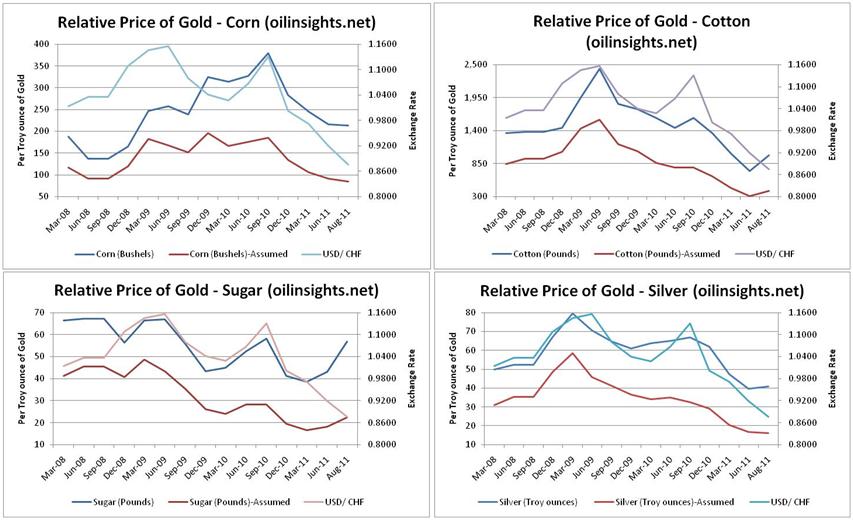
In its “Handbook in Central Banking”, the Bank of England notes the following motives to hold gold:
- “The “war chest” argument – gold is seen as the ultimate asset to hold in an emergency and in the past has often appreciated in value in times of financial instability or uncertainty.
- The ultimate store of value, inflation hedge and medium of exchanges – gold has traditionally kept its value against inflation and has always been accepted as a medium of exchange between countries.
- No default risk – gold is “nobody’s liability” and so cannot be frozen, repudiated or defaulted on.
- Gold’s historical role in the international monetary system as the ultimate backing for domestic paper money”.
When it comes to relative value it’s the second argument that we are really interested in. “A store of value, inflation hedge and medium of exchange”.
A number of analysts now look at Gold not as an investment but as an alternate exchange for storing, preserving “money” or “value”. It reflects the original attitude towards gold before the Bretton Woods agreement was discarded on 15th August 1971 replacing gold as the final exchange of value with the US dollar as the international reserve currency for the world. Interestingly enough it was the macro economic shocks generated by the Vietnam War and the oil embargo that led to a rise in the price of gold from 35 dollars an ounce in the late 1960 to 150 dollars an ounce in 1974. 7 years later gold peaked at 850 dollars an ounce in January 1981.
It is also an interesting exercise to see how this relationship between gold and value has held over the last two thousand year of recorded history as wars amongst nations destroy purchasing power of their currencies and feed a run on gold to preserve wealth. While we don’t have price data going back two thousand years we do have some information on gold prices as well as gold to silver ratio courtesy of the measuring worth project at University of Illinois at Chicago.
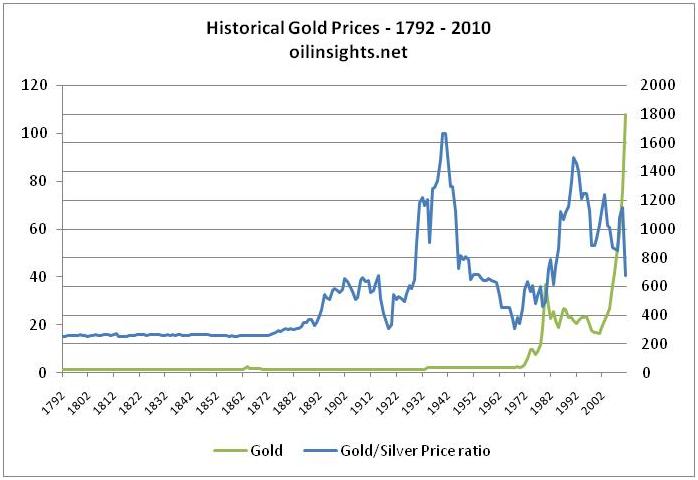
You can clearly see the impact of the Great Depression, the First and Second World War as well as the Vietnam war on the Gold/Silver price ratio and then on gold prices after the expiry of the Bretton Wood agreement. For our context today it’s the shift in mindset from wealth creation (gold as an investment) to wealth preservation (gold as a store or unit of value) that marks the rise in the value of yellow metal.
Weakness of Reserve and safe haven currencies
While part of the volatility in commodity prices originated from real and perceived supply and demand imbalances, a large part was triggered by the weakness of the US dollar. This was not an issue before 2007 since some analysts and investors felt that any weakness on part of the dollar would be compensated by the strength of the Euro, the Yen and some day by the Chinese Yuan. Unfortunately with the European Central Banks PIGS (Portugal, Italy, Greece and Spain) debt crisis the Euro took a bath, the earthquake-tsunami-radioactive meltdown resulting rise and volatility in the value of the Japanese Yen removed it from this equation leaving the world of finance struggling to find a replacement for not one but three safe havens. While to a large extent dollar and yen are still used as temporary safe havens during flight to safety events, an increasingly large number of investors have started using gold as their permanent store of value.
To illustrate two graphs below shows euro’s increasingly erratic behavior against the US dollar over the last two years reversing three years of steady gains as well as the Japanese yen’s march against the US dollar.
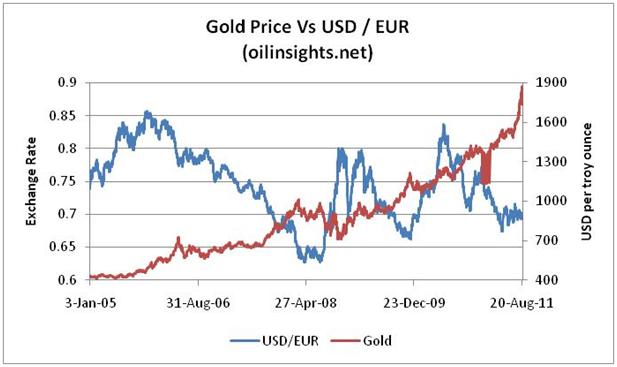
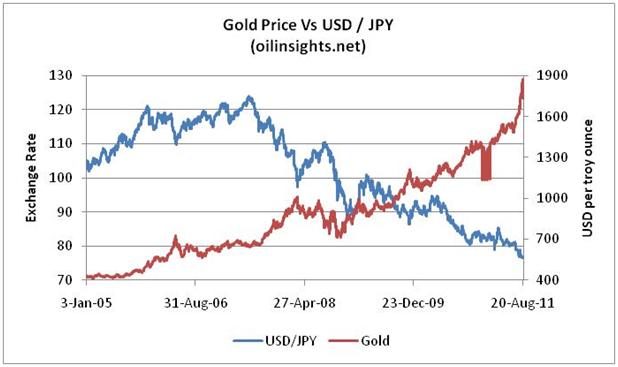
As Dr. Michael Pettis points out at China Watch, there are many costs associated with being a reserve currency and not all countries are willing to bear those costs. As the world tries to place other candidates on the reserve currency pedestal it become abundantly clear that there are not many willing, fit or able candidates for this role, the Swiss Franc and SNB being the latest casualty of this search.
In such a scenario gold has no option but to become the default currency of choice. More than investors and speculators it is Asian and European Central Banks with surplus liquidity that have been snapping up the yellow metal turning them net buyers of gold from net sellers over the last few years. China, Russia, Thailand, Korea, Vietnam and India have been acquiring gold to maintain or bring their gold reserves to outstanding currency ratios closer to Western central banks.
“To gauge the size of potential gold purchases from emerging market countries, market participants often look towards gold ownership in developed nations, e.g. in the US or Germany, whose gold holdings make up more than half of their reserves. However it should be kept in mind that gold holdings in developed countries are a legacy from the gold standard and the economic objective of emerging markets is geared towards developing domestic economies, so accumulating large gold holdings may not be the best way to utilize reserves.”
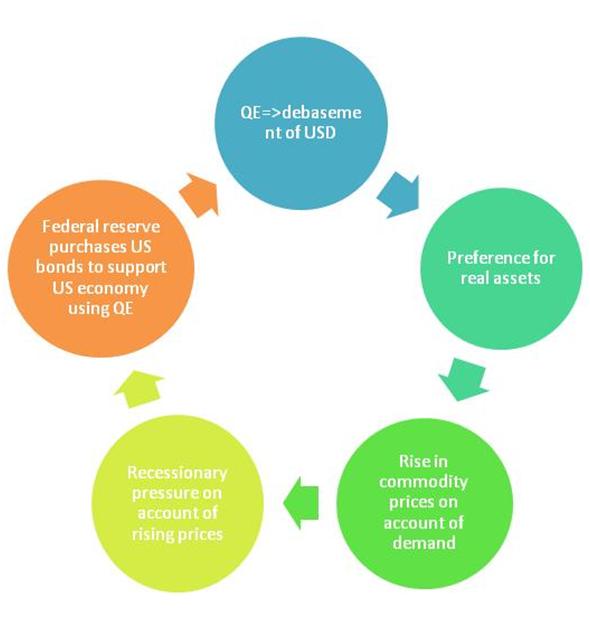
The same central banks till very recently (in economic terms) were perfectly happy parking their surplus liquidity in US dollar denominated assets but given Quantitative Easing cycles and credit rating concerns became net buyers of real assets and precious metals. While this hasn’t really effected the demand for US dollars and treasury bills (still considered the primary safe haven and sellers of real assets are still parking their dollar proceeds in US treasury bills), it has had a significant impact on commodity and precious metal prices further increasing the pressure on the US dollar and the US economy. As this pressure build, the Federal Reserve gets pushed towards even more inflationary measures to jump start and support its domestic economy, further feeding the cycle.
Is Gold safe at current price levels?
But does this central bank buying means that gold is safe for ordinary mortals? Can we as individual retail investors use it with the same sense of security that central bankers have been buying it? The answer to this question is dependent on your entry level. If you bought gold at its peak in January 1981 you would have had to wait twenty years to realize a positive return on your investment. In the high inflation years of the 80’s you would have been stuck with an investment yielding a negative carry and a 50% loss on your purchase cost if you bit the bullet and took an exit.

Here is a truncated graph showing the Gold/Silver price ratio between 1967 and 2011, marking the first rise in the value of gold after the Vietnam War and the oil embargo. The common theme in this dataset is whenever Gold/Silver ratio heads south, gold tends to follow suit.
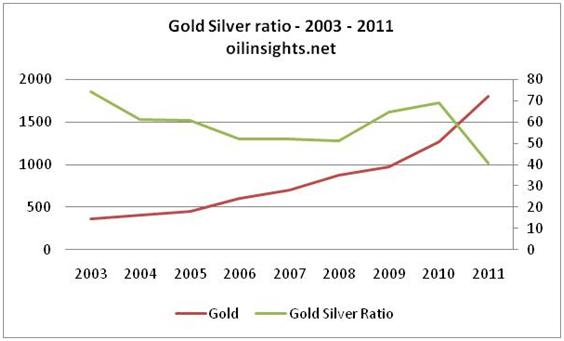
The only exception for the downward drift from 2003 – 2007 that should have led to sharp decline in the value of gold but was possibly short circuited on account of the Iraq/Afghan war and the global financial crisis that fed more uncertainty in the mix. So the question you have to answer before you add more to your position of Gold is what does the most recent downward revision in the Gold/Silver ratio implies? Will gold head south or like 2003 take off for another heady ride to an all time high?
That is the 1800 / 1200 dollars an ounce question.
Update May 2014. Three years later we ran the same analysis on the updated 2012-13-14 gold price data sets. The primary question was that after a drop of 30% would the relative value argument still hold when it came to gold price forecast? To see the results and the graphs from that exercise see Is Gold still overvalued in 2014.

Fantastic analysis!
Thank you Vasseh. Glad you liked it..So are you buying or selling?
I bought Gold @ 1826/- per ounce which has been the peak in the last one month. Is it wise to retain it and buy more Gold now?
Please note that this is not investment advise, just my personal humble opinion. All investors need to do their own diligence before making trading decisions. There should be a dead cat bounce over the next few days and prices should rise at-least once or twice to a level higher than 1700. If I could cut my losses, I would exit rather than buy at a dip. As the article says gold is neither a hedge (inflation) or a safe bet at these levels, there is a good chance that we may see a further reduction in price.
Wonderful website. A lot of helpful info here. I am sending it to some friends ans additionally sharing in delicious. And obviously, thank you for your sweat!